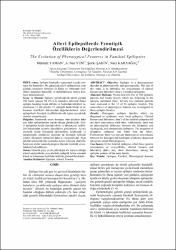| dc.contributor.author | Yaman, Mehmet | |
| dc.contributor.author | Yeni, S. Naz | |
| dc.contributor.author | Şahin, Şevki | |
| dc.contributor.author | Karaağaç, Naci | |
| dc.date | 2015-02-03 | |
| dc.date.accessioned | 2015-02-03T11:53:47Z | |
| dc.date.available | 2015-02-03T11:53:47Z | |
| dc.date.issued | 2007-05 | |
| dc.identifier.issn | 1302-4612 | |
| dc.identifier.uri | http://hdl.handle.net/11630/1869 | |
| dc.description.abstract | Amaç: Epilepsi fenotipik ve genotipik olarak heterojen bir hastalıktır. Bu çalışmada ailevi epilepsilerde aynı ailedeki hastaların birbirleri ile klinik ve laboratuar özellikleri açısından benzerlik ve farklılıklarının ortaya konması amaçlanmıştır.
Gereç ve Yöntem: Epilepsi polikliniğinde takibi yapılan 580 hasta içinden 94 (%16.2) tanesinin ailesinde başka epilepsi hastalığı tespit edilmiş ve bunlardan tetkikleri tamamlanan 33 aile içinden 72 epileptik hasta klinik ve laboratuar özellikleri bakımından değerlendirilerek ailevi epilepsilerin fenotipik özelliklerinin aile içinde uyumluluk oranları araştırılmıştır.
Bulgular: Sendromik tanısı homojen olan ailelerin daha çok fokal epilepsilerden kurulu olduğu görülmüştür. Ailevi epilepsiler kendi içlerinde klinik ve laboratuvar özellikleri bakımından uyumlu olmadıkları görülmüştür. Ayrıca etyolojik olarak idiyopatik epilepsilerle, kriptojenik ve semptomatik epilepsiler arasında da fenotipik farklılık yoktur. İdyopatik epilepsiler daha iyi prognozludur. Aynı şekilde sendromik tanı açısından tanısı homojen olanlarla, heterojen aileler arasında prognoz dışında fenotipik uyumluluktan bahsedilemez.
Sonuç: Genetik geçiş ya da yatkınlığın söz konusu olduğu ailesel epilepsilerde, aynı ailedeki epileptik fertler arasında klinik ve laboratuar özellikler farklılık gösterebilmektedir. | en_US |
| dc.description.abstract | Objective: Epilepsy is a heterogeneous disorder as phenotypically and genotypically. The aim of this study is to determine the concordance of clinical features and laboratory data’s in familial epilepsies. Materials Methods: Ninety-four (16.2%) of 580 epileptic patients had family history which are following in the epilepsy outpatient clinic. Seventy two epileptic patients were evaluated at the 33 of 94 epileptic families. The concordance of phenotypical features was investigated in these epileptic families.
Results: Homogenic epileptic families which are
diagnosed as syndromic were focal epilepsies. Clinical features and laboratory data’s of the familial epilepsies did not show concordance each other. Additionally, there was no phenotypical difference between the idiopathic and cryptogenic, and symptomatic epilepsies. The prognosis of idiopathic epilepsies was better than the others. Furthermore, there was not any phenotypical concordance between the homogen and heterogen syndromic diagnosed epilepsies except their prognosis.
Conclusion: In the familial epilepsies which have genetic transmission or susceptibility, clinical features and laboratory data’s may show discordance among the epileptic patients of the same family. | en_US |
| dc.language.iso | tur | en_US |
| dc.publisher | Afyon Kocatepe Üniversitesi, Kocatepe Tıp Dergisi | en_US |
| dc.rights | info:eu-repo/semantics/openAccess | en_US |
| dc.subject | Epilepsi | en_US |
| dc.subject | Ailesel | en_US |
| dc.subject | Fenotip | en_US |
| dc.title | Ailevi epilepsilerde fenotipik özelliklerin değerlendirilmesi | en_US |
| dc.title.alternative | The evalution of phenotypical features in familial epilepsies | en_US |
| dc.type | article | en_US |
| dc.relation.journal | Afyon Kocatepe Üniversitesi, Kocatepe Tıp Dergisi | en_US |
| dc.department | Afyon Kocatepe Üniversitesi, Tıp Fakültesi, Nöroloji Anabilim Dalı | en_US |
| dc.department | İstanbul Üniversitesi, Cerrahpaşa Tıp Fakültesi | |
| dc.department | İstanbul Maltepe Üniversitesi, Tıp Fakültesi | |
| dc.identifier.volume | 8 | en_US |
| dc.identifier.startpage | 5 | en_US |
| dc.identifier.endpage | 10 | en_US |
| dc.identifier.issue | 2 | en_US |
| dc.relation.publicationcategory | Makale - Ulusal Hakemli Dergi - Kurum Yayını | en_US |



















